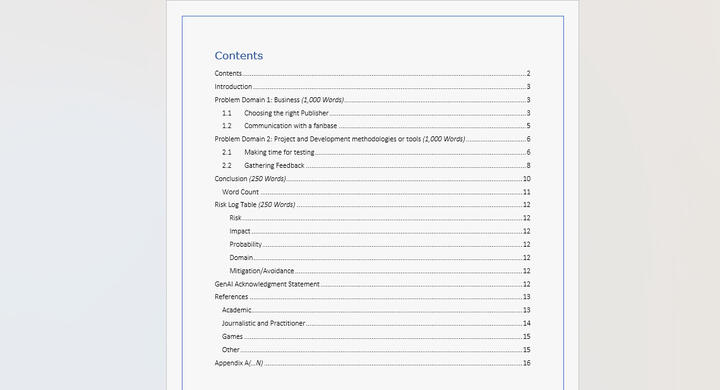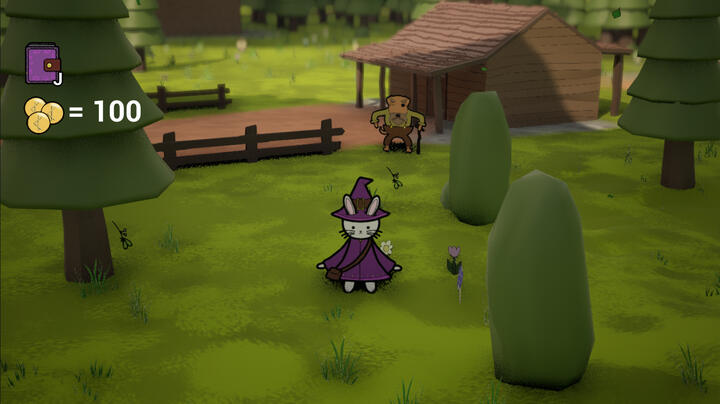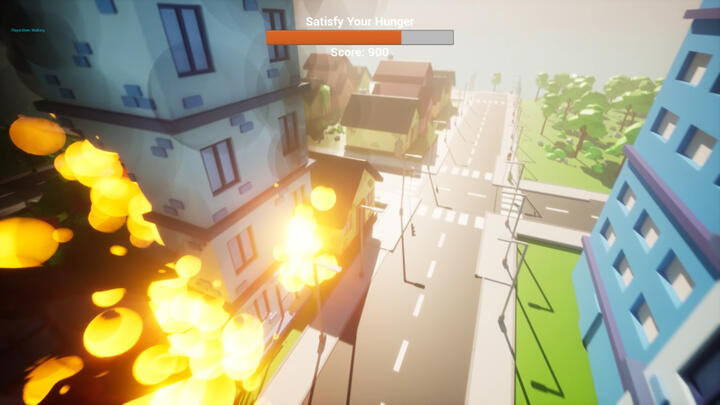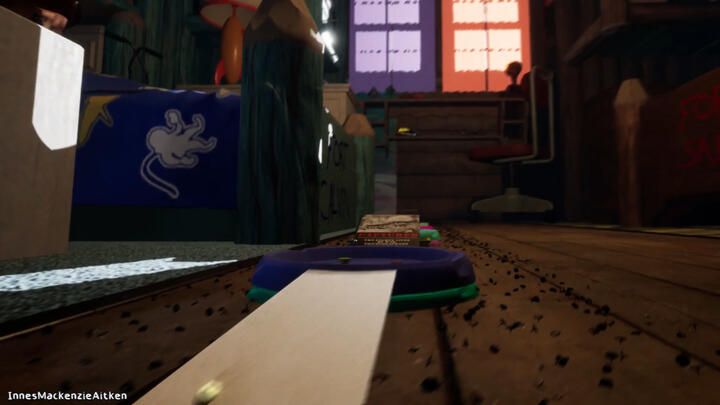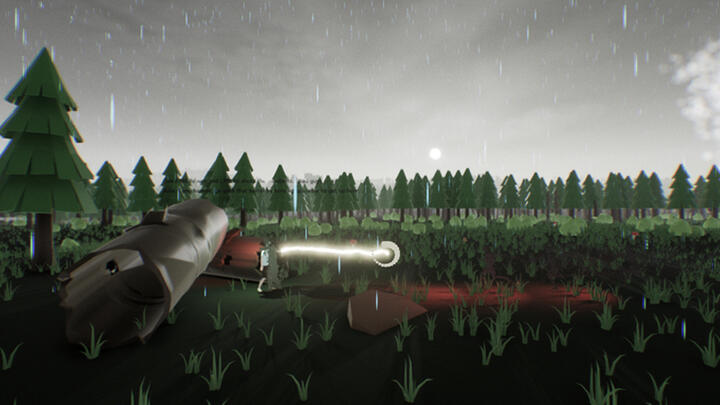Innes Aitken
Producer - Designer
Abertay University Student: Game Design & Production BA Hons
President of the Abertay Game Development Society (Previous, 2024-25)
Club leader Rep Panellist @ GDC 2025
Currently based in Dundee, studying at Abertay University and in my final year. I am focussing on roles in production and design. Fascinated by all workflows in game development with experience within them to have a better understanding of working with them.
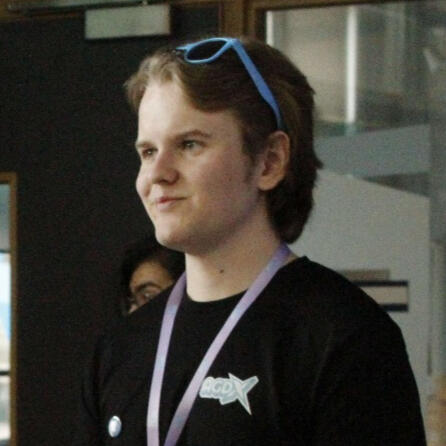
Highlighted
Click on projects to read more
Managed the Abertay Game Development Society's weekly events such as Industry Talks and game jams, building team structures and serving as its first point of contact.
Streamlined Event preparation and delivery
Founded the Abertay Game Development Expo
Initiated Brand and event volunteering opportunities for students
The first ever student micro panel at Game Developers Conference about game clubs like AGDS and their value to the future of the game industry.
Represented Abertay University & AGDS
Worked as part of a team of 5 on proposal and delivery content over 3 months
74 attendees with a 90% positive talk evaluation
Projects
Filter projects by category. Hover projects to view skills
Let's Chat
Codename: Kids room
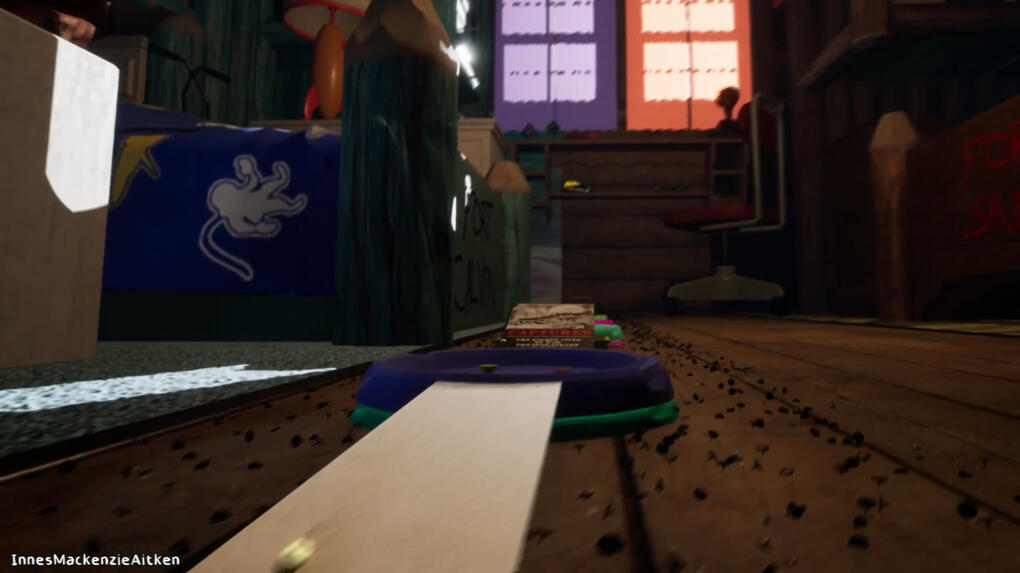
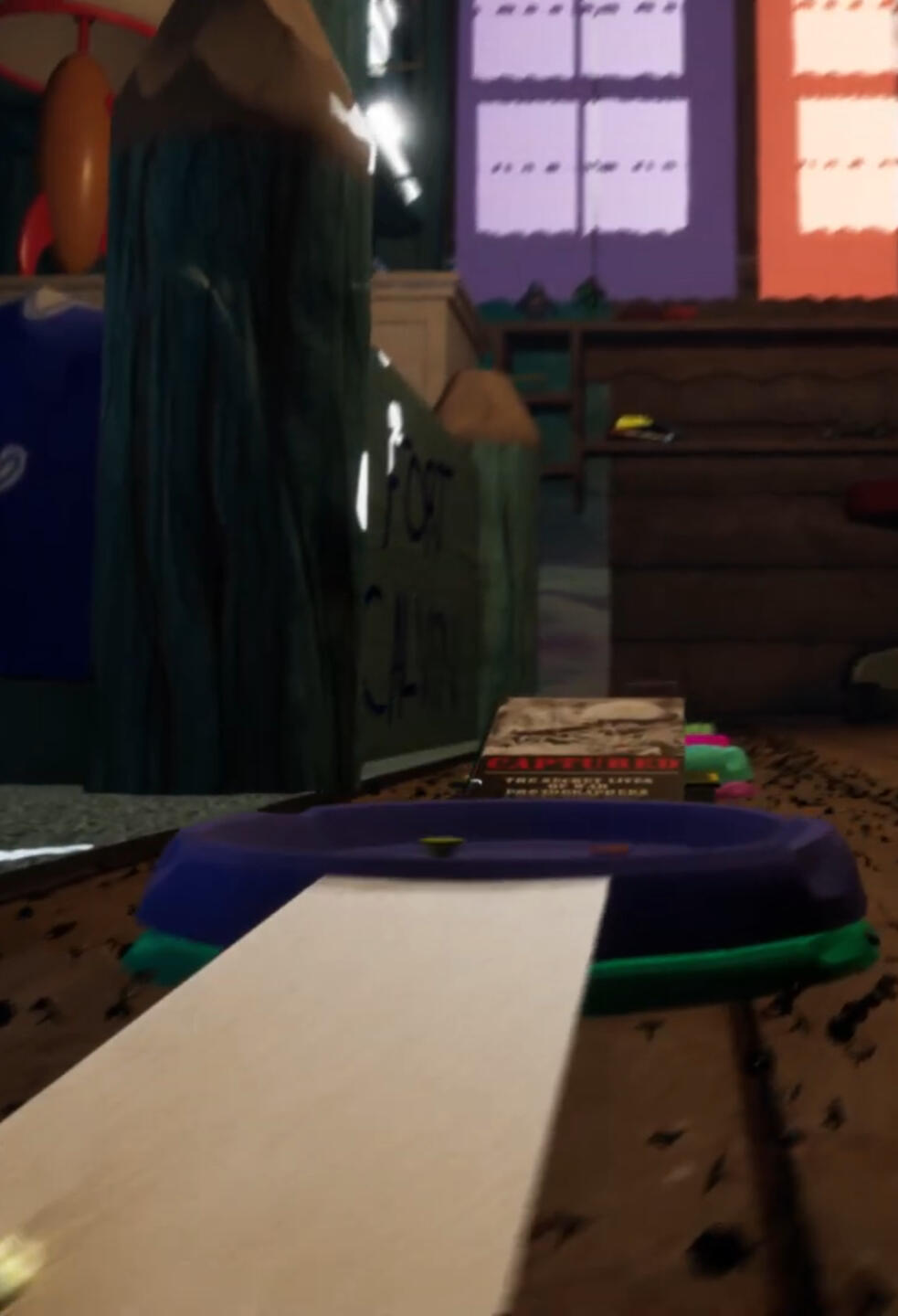
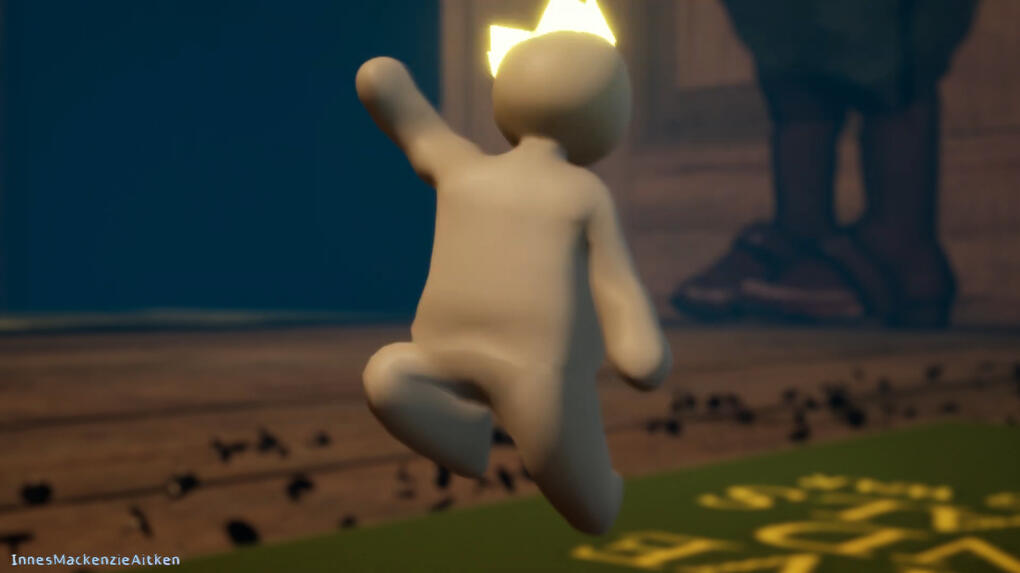

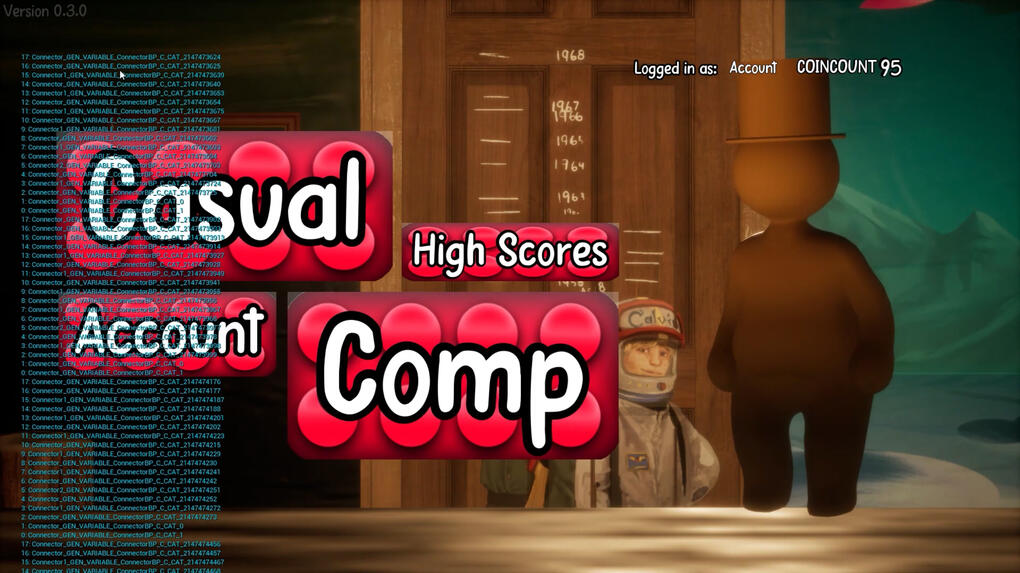
Project Summary
Codename: Kid’s Room is a game prototype I made during my second year of college. It is a challenge game where the player must complete an obstacle course . They can also keep track of their scores, compete with others, and earn rewards.I made this game for a college assignment in which where the aim was to create a rapid prototype for a hypothetical client. This ‘client’ wanted an obstacle course game. It challenged me to think about what companies and audiences look for in my work, and further develop their ideas.The game is set in a childhood bedroom. As the target audience is 16 year olds and I created it in 2021, it is set in the late 2000s-early 2010s. I kept this in mind when designing the look of the game. The colours are vibrant, menu buttons resemble Lego bricks, and the player character looks like a clay model.Casual game mode is easier and more colourful. The colours are randomly generated (though always vibrant) and so are the obstacles. This mode is ideal for players looking for a fun and easy experience.Competitive game mode is harder and gloomier. It is the game’s ‘dark side’ designed for players who wish to compete with others online. The competition functions by comparing data from multiple accounts and ranking them on a leaderboard that all players can see. To ensure this is fair and accurate, competitive mode does not have randomly-generated obstacles.In both game modes, I keep the player on track with the objects I have added outside the course that kill the player. Sometimes they’re pins, sometimes they’re peanuts, but they’re always deadly. To accompany this, I made a death animation where the player crumbles/disintegrates. I created this by experimenting with particle systems, eventually creating one that would emit from the player character’s final pose, blending in enough to appear as though they are disintegrating.At the end of a game, the player earns a number of coins that is determined by subtracting their time in minutes from 200. These coins can be used to purchase accessories for their character in the menu screen. The time is also stored, to compare with their other times (high scores) or other players’ times (leaderboard).Aim of the game:
Is this a dream? You have woken up in your childhood bedroom, but you’ve shrunk to the size of one of your toys! Beat the treacherous obstacles as quick as you can, and don’t stray from the path! Don’t forget to compete with your friends, earn coins, and customise your character!
Software Used:
Software used:
Unreal Engine, Maya, Photoshop, PlayFabPlayfab: The player can create an account, the data of which is stored online. This means that their account details, scores, coins, and custom character will all be saved, and players will be able to appear next to each other on a leader board. I did this using an API called PlayFab.Programming: I programmed it in Unreal Engine. I had prior knowledge of this, and had experimented with online leaderboards when I made my PandaBugz game, so this game was a chance to practise my programming skills and get used to using an API to incorporate online features.Art: To create the player character, I first had to draw some concept art, then create a 3D model. To bring it to life, I rigged and animated it.Grade received: Distinction
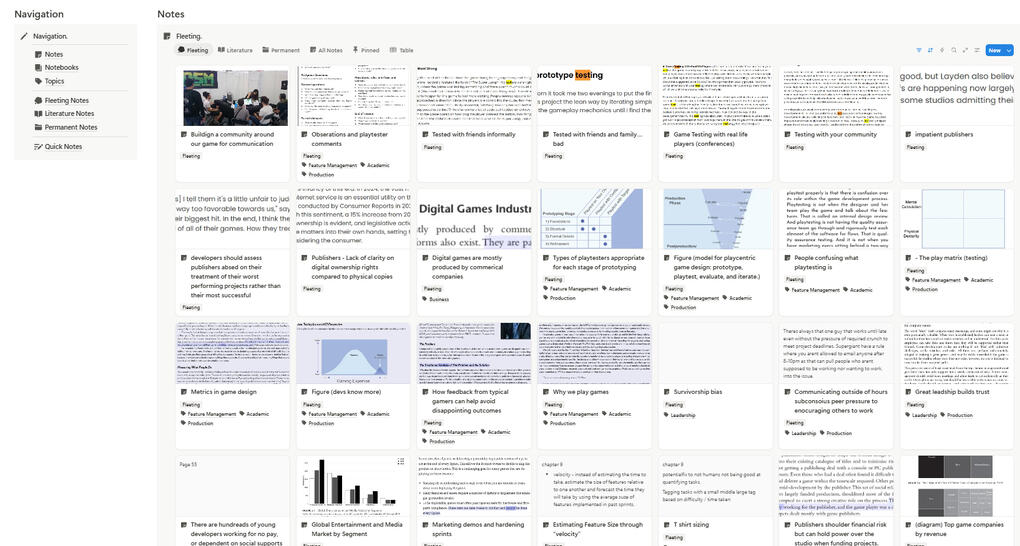

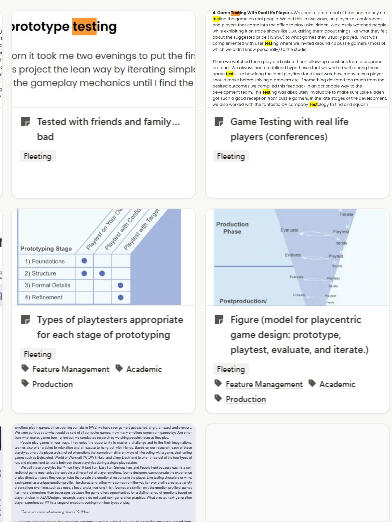
Project Summary
Reflection:
This module and case study have been helpful for me in understanding the different development techniques and strategies involved with the production of games such as:
– Risk Management & User research
– SCRUM & AGILE Production Processes
– Team Dynamics, Business Models & LeadershipAs well as exploring different studios experiences online by developing a zettlekasten of research.Research:
Within this case study, I highlight the risks can face during development for a hypothetical game studio for an 18-month production time for their game project. I go on to discuss potential issues within Business and project / development methodologies and tools by talking about ideas such as maintaining mutual interest with a publisher, communication with a fanbase, testing with said fanbase and ensuring you have the time to achieve this.Business:
I begin by talking about choosing the right publisher in an inflated market after the pandemic’s gaming binge. Establishing a fair contract and maintaining relations with milestones to justify publisher investment throughout production. I then speak about communication with a fanbase and the importance of maintaining expectations and the value of pre-orders and avoiding disappointment and awareness of other studios cloning your work before release.Project and Development methodologies and tools:
I begin this section by talking about making time for testing in a world where technology is always changing and there never been more people playing games before where bugs can be noticed more frequently as a result. Finally I talk about gathering feedback and the importance of understanding what players are asking for and what they are trying to ask for!
Submission:
Grade Received: A
Art Gallery
Click photos to enlarge
Terra
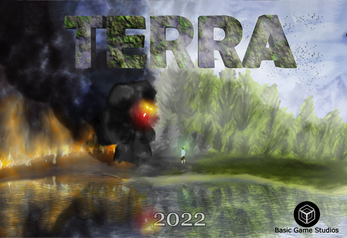
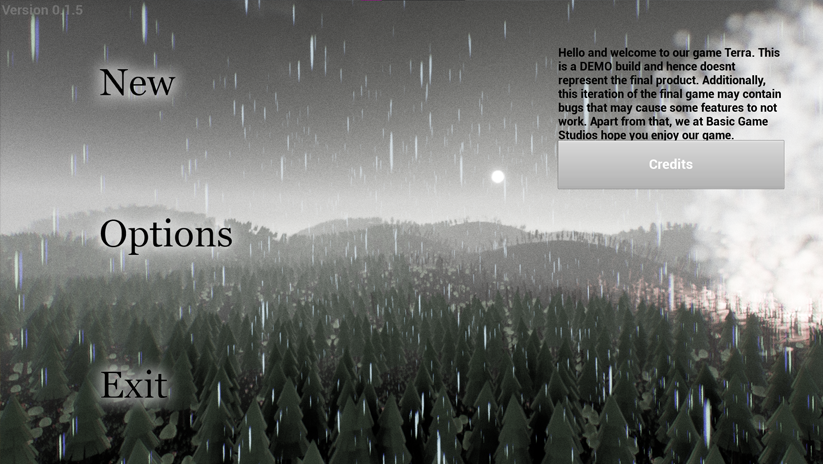

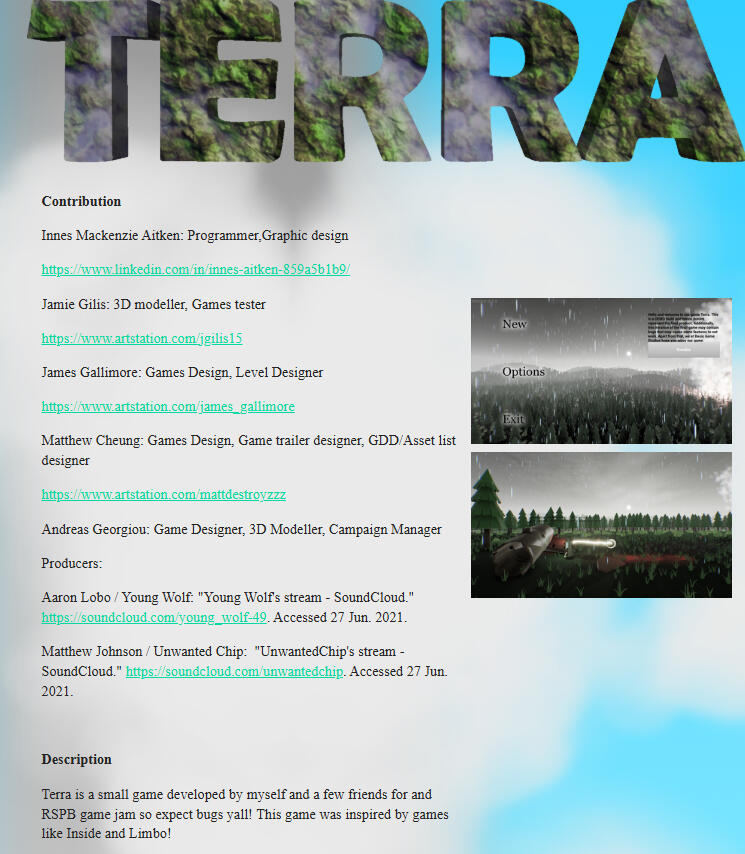
Project Summary
Inspired by games such as Inside and Limbo, Terra is a side-scrolling game in which players have to navigate the world by solving puzzles. Eventually, there is a final boss fight.I made this game with some classmates over a month for a charity game jam for Royal Society for the Protection of Birds. It was my first ever game jam, so I learnt a lot.It was play-tested by my college peers, which was a success. Looking back, it is quite simple, but I’m extremely proud of it as both my first group project and my first game jam.Aim of the game: Explore the wilderness, solving puzzles to survive as you quest to discover who is destroying the environment. Beware, there is danger ahead!
Software Used:
Software used:
Unreal Engine, Maya, PhotoshopProgramming: I learnt Unreal Engine programming for this project. Notably, I managed to create particles for rain.Art: I created 3D assets for this project using Maya. In addition, my graphic design skills were put towards creating the game’s logo and poster.Collaboration: Over the course of this project, I became familiar with the bumps that come with learning to work as a team.
PandaBugz
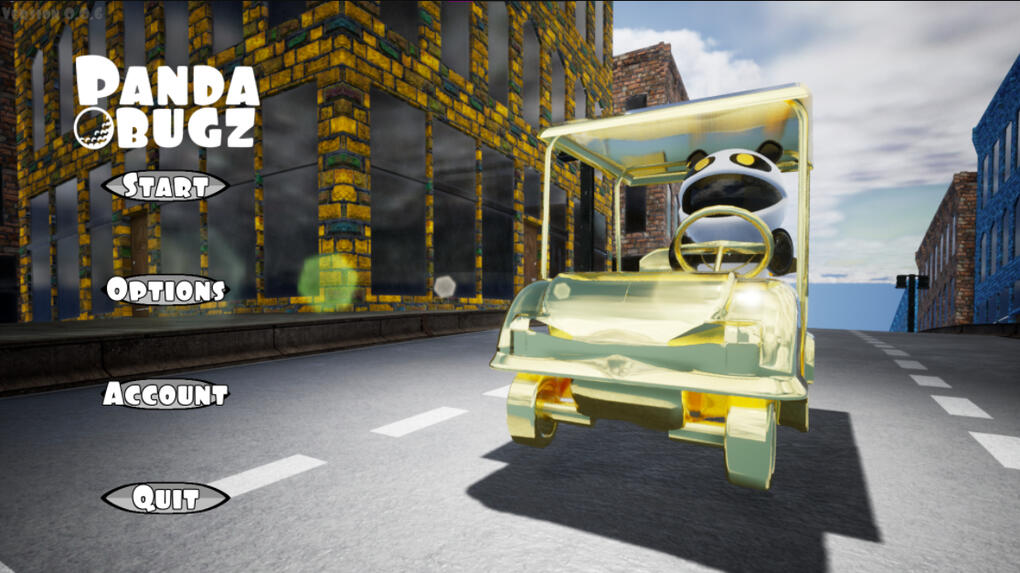

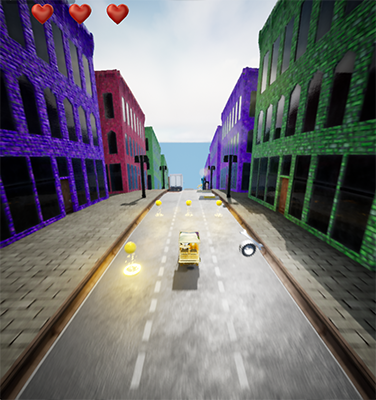
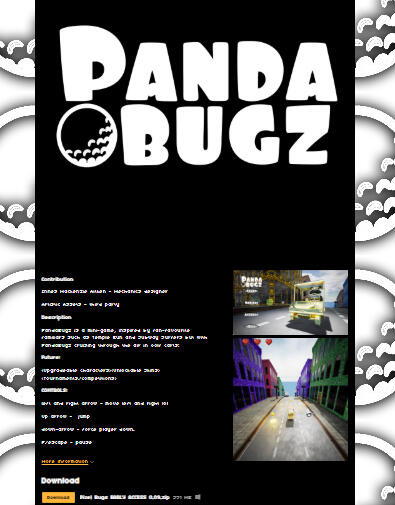
Project Summary
PandaBugz is a new re-imagining of fan-favourite games such as Temple Run and Subway Surfers. I completed it over 6 weeks over the Summer of 2021 in order to satisfy a client.This was my first professional project outside of education. My client was one of my college lecturers at the time who recognised my skill in game development.Players can make accounts that are stored online in order to compete with other players in a leaderboard.Another key feature is the power-up system. Along the way, the player encounters several objects that boost their progress.Aim of the game: PandaBugz is an endless-runner minigame inspired by fan-favourite familiars such as Temple Run and Subway Surfers but you play as PandaBugz cruising through the air in golf carts!
Software Used:
Unreal Engine, PlayFab APIProgramming:
I programmed the entire game in Unreal Blueprints. This project required me to implement online data storage, which I had never done before. I also programmed an infinite procedurally generated environment.Design Skills:
Though the 3D assets were third-party, I designed both the user interface and the game’s sound.
Working with a Playerbase:
My client had an established community, so I was able to gain experience working with a playerbase.Platform Optimisation:
I ported the game to mobile and learnt how to optimise it.
We Are Souls
Project Summary
We are souls is a first-person, round-based survival game. What started as a funny voice message to throw out a concept became a short but sweet game about kicking waves of angry bowling pins. Alongside 3 of my classmates, I completed this project over the summer after my first year of study. We had 4 days (1 day planning. 3 days production) to execute this idea. This took place in August 2023.The aim of this project was to exercise the skills we gained from out first year of study and put them to test within a short time frame.Aim of the Game:Enter a world crawling with adorable ‘souls’ that will stop at nothing to strike fear. These pocket-sized troublemakers squish, wobble, and squeak as they try to knock you off your feet! Hold onto your sides because, when you pluck them up by their tails, their squealing and cursing grows in absurdity.‘We Are Souls’ dares you to keep upright and have a ball as you come foot-to-face with waves of audacious critters. Grab ‘em, throw ‘em, punt ‘em to daze ‘em and don’t forget to swing ‘em to slap the others!
Contribution:
Software used:
Unreal Engine, Trello, Maya, PhotoshopProgramming: This project was a welcome chance to develop my proficiency in Unreal Engine blueprints.Production: My team contributed to a board on Trello. This allowed us to stay on task and monitor each other’s progress. Production was important to this project due to the short time frame, so we had to check each other and make sure we were doing things as effectively as we could. When we couldn’t meet in person, we used Discord to communicate.Ideation to action:Creating a prototype in four days called for rapid ideation. We had to be quick to come up with ideas to get working as soon as possible, and ruthless when it came to cutting ideas for the sake of the scope.
Bingus the Menace
Project Summary
Bingus the Menace is a project I worked on alongside third and fourth-year students. It was part of the Abertay Game Development Society’s freshers-week game jam. Its short time frame allowed me to improve how I work under a short burst of pressure. Overall, I feel that this game helped me sharpen my skillset.It is a 3D, first-person game including NPCs whose colours, species, and accessories are randomly generated.I made it at the start of my second year at university in order to practise the skills I learnt over my first.Short-term projects like this one allow me to try out new roles. My course of Game Design and Production accommodates many disciplines within game development, providing students with production skills alongside the opportunity to nurture their interest in art and programming. This has left me torn between the coordination that comes with production, and the puzzle-solving that comes with programming, so I took this on to help find my ideal role.Experimenting with team dynamics:
I wanted to understand the types of people I enjoy working with, and learn to adjust for if I am assigned a team in the workplace.The aim of the game:
You play as Bingus, a big, green monster who, like the rest of us, must eat to live. Unlike us, his diet consists strictly of cute, fluffy animals. You must keep his hunger from running out by rampaging through the town and eating any creature in sight!Showcase to Industry:
We then had our game played at the Abertay Game Development Society play party by local industry, such as Team Terrible.
Contribution:
Software used:
Unreal Engine, Trello, Discord.
Chairing meetings:
I was responsible for the coordination and chairing of meetings and ideation sessions. These meetings were both remote and in-person.Leadership:
Throughout the project, I led my team in person and online to make sure we stayed on track. This proved successful as we had a playable prototype by the end of the week.Programming:
Through this project, I was able to develop my programming skills. I used blueprints, the style of scripting I am most confident with serving as good practice through optimisation.Conceptualisation:
As we only had a short time to make this game, we had to come up with a concept quickly. To do this, I tested out an ideation technique that my team found helpful. This began with making a mind map including primitive ideas as small as mechanics or styles. We then spent 1-3 minutes building upon them, then quickly voting on what to keep and what to slash. We then repeated this process until left with 3-5 ideas. These ideas were anonymously ranked from best to worst, and the position of each idea was added up. This meant that the lowest-scoring idea was the winner. Ties were to be resolved by a coin flip or another vote. This method proved effective and enjoyable.Team building:
To build confidence and chemistry within the team, I organised some icebreakers. We met up in the campus coffee shop to discuss ideas and get to know each other, then bonded over a game of UNO. To me, icebreakers are essential because they make the teambuilding process more enjoyable and encourage people to put forward their ideas without fear.
Point
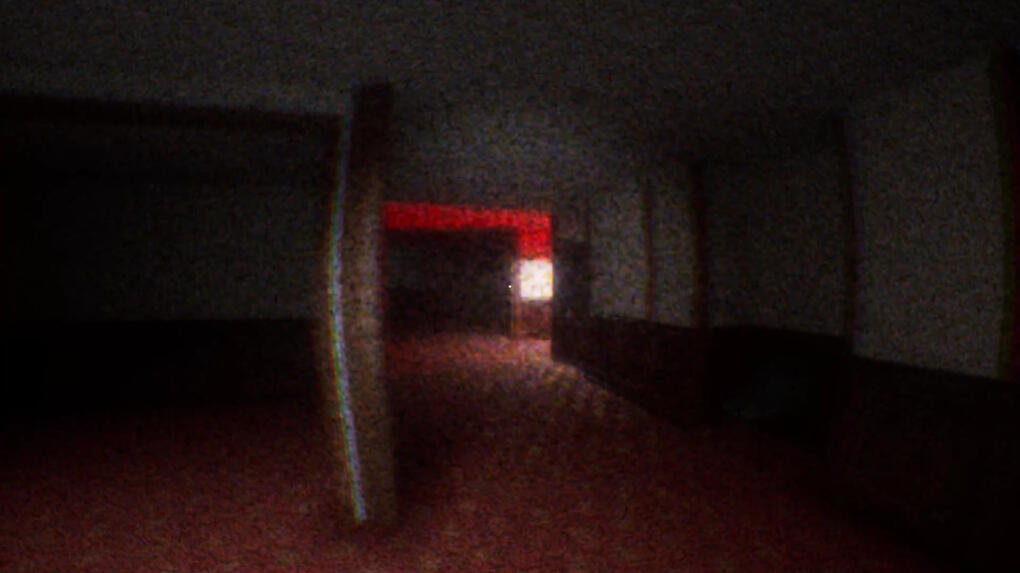


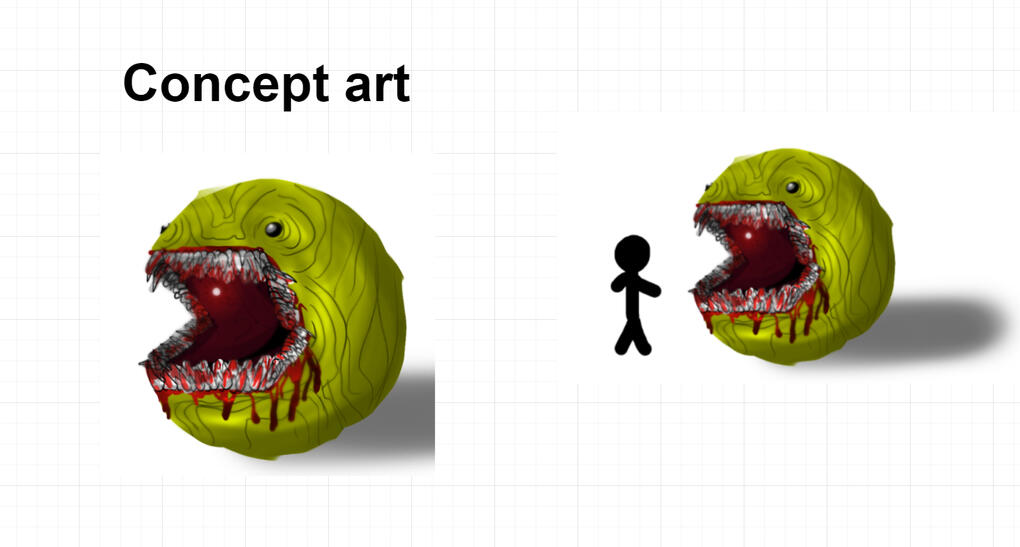

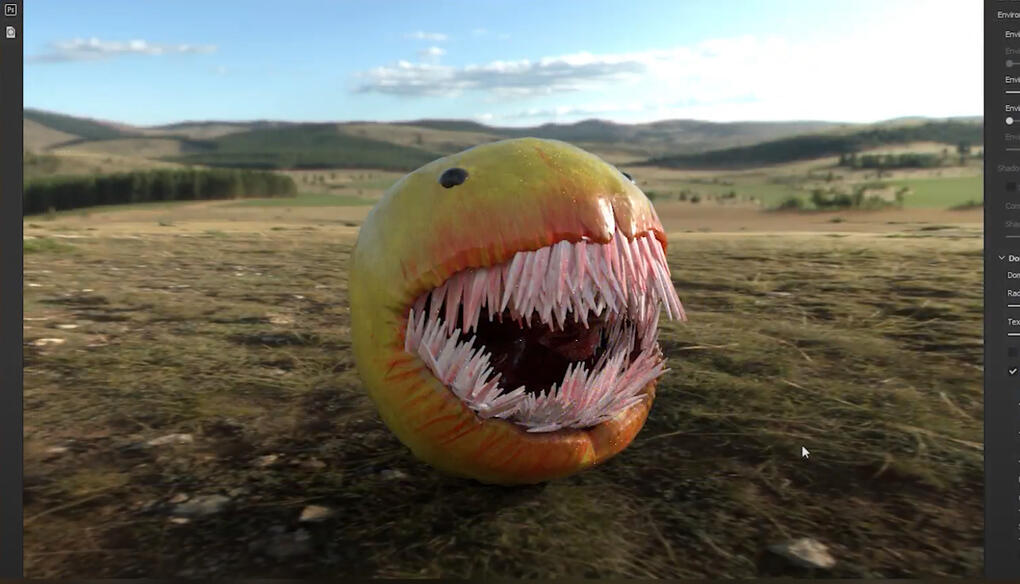
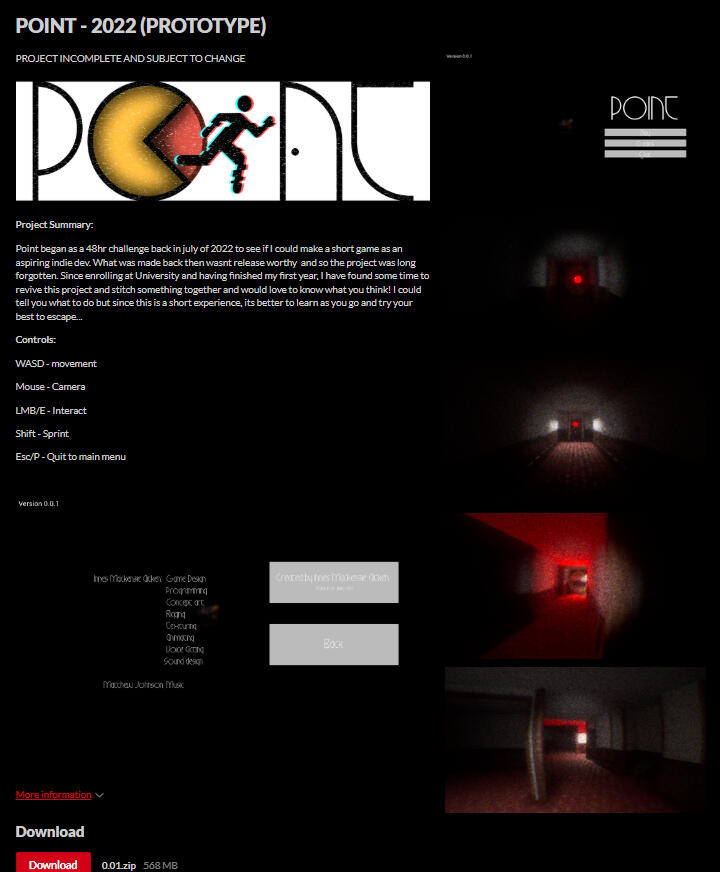
Project Summary
Point began as a 48-hour challenge in July of 2022 to test the skills I learned during my time in college. I was fascinated by how much I achieved in the jam and wanted to smooth out the player experience. During my first year of university, I made time to expand the project and further exercise my skills. I would love to revisit this project in future.Point is a horror remake of Pac-Man where the points (pellets that Pac-Man eats) are people and you are the last one. You must navigate an uncanny hotel corridor in search of safety from the creature that follows. Don’t let the lights go out!
Conceptualisation:
Tools used: Photoshop, draw.ioGame Design:
Created the overall game concept and mechanics using draw.io
Concept Art:
Developed detailed and horrifying concept art for Pac-Man and the game environment using Photoshop.I came up with this horror twist on Pac-Man where the player navigates a dark, maze-like environment from a first-person perspective. The goal of the game is to press buttons at positions in the map that mimic the original game’s power pellets. The player acts as Pac-Man’s final pellet and must avoid being eaten by a grotesque re-imagining of the character.Pac-Man is attracted to noise and will chase the player upon buttons being activated. This forces the player to be confronted by him multiple times encouraging them to keep moving through the level. Once the player activates all buttons, the exit is unlocked but Pac-Man is put into a frenzy and knows exactly where they are.Pac-Man has a light in his mouth inspired by that of an angler fish. It was designed to be the same shape as a button to confuse the player into approaching him. He is stationed at the end of corridors to incite this confusion.
Production:
Tools used: Unreal Engine, Maya, Substance Painter, Adobe AuditionSound Design: Composed and edited sound effects and music using Adobe Audition.
Programming: Coded the game logic, enemy AI, mechanics, and player interactions in Unreal Engine.
Animation & Rigging: Modeled, rigged, and animated the Pac-Man monster using Maya.
Texturing: Applied detailed textures to the models and environment using Substance Painter.
Witch is Which

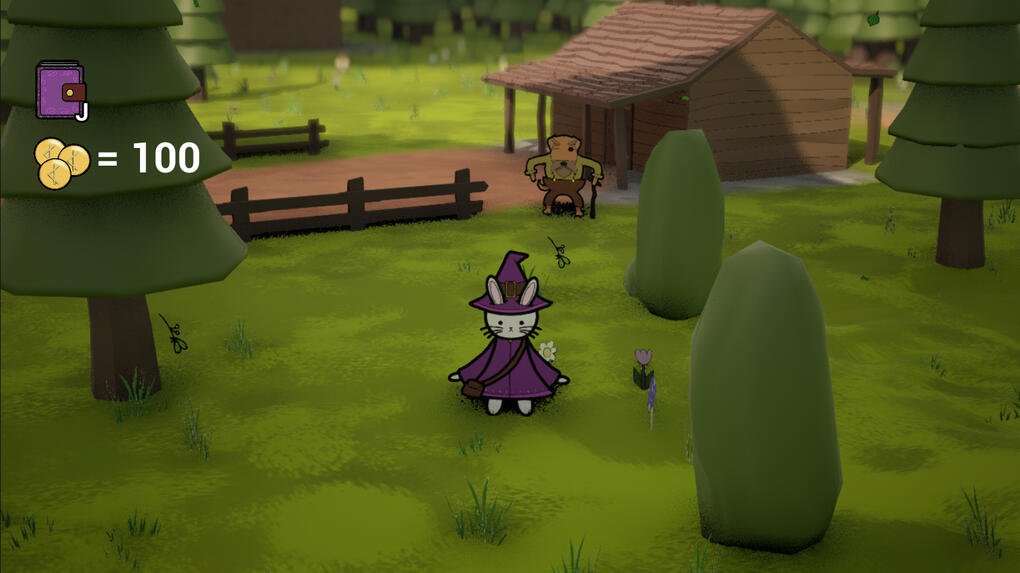
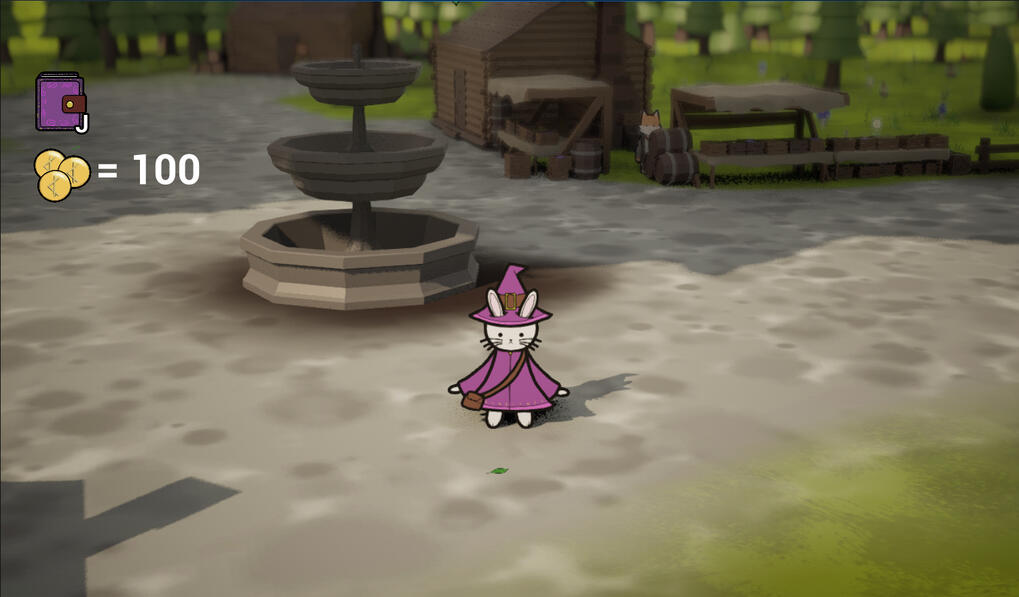
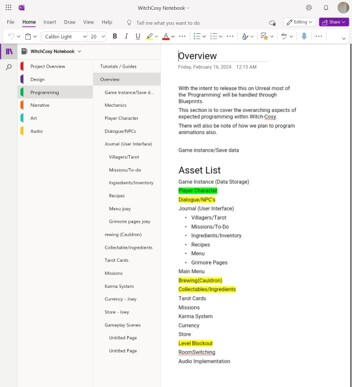
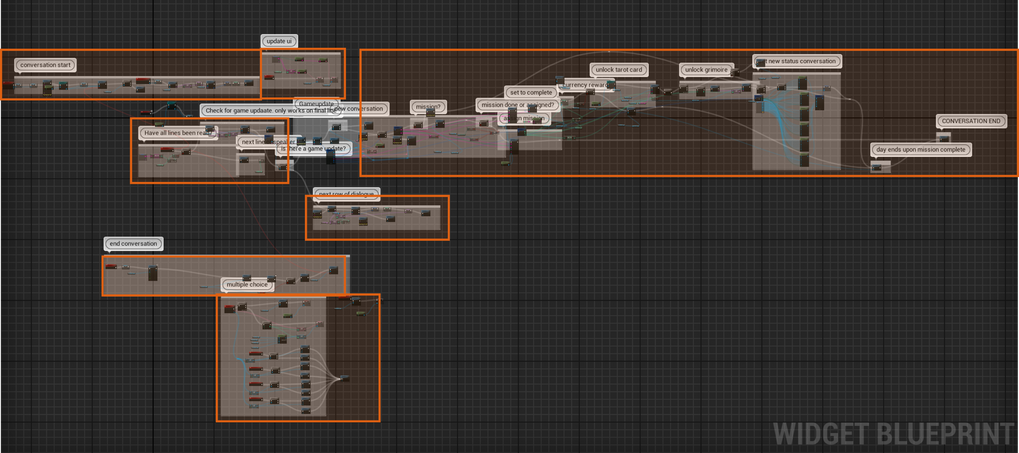





Project Summary
“Witch is Which?” is a collaborative game development project by team Antlia. It is an isometric 2.5D game where players take on the role of a witch in a small village, brewing potions for rewards. This game’s development involved phases, including ideation and pre-production, production, and post-production, documented meticulously across 14 weeks.I did this project for my DES207 collaborative module with different games courses at Abertay. These are Games Design and Production and Computer Arts. Witch is Which started as one of my ideas for a speech-to-text game in which a Witch character enlists different creatures to help them brew potions. Upon developing this idea with my teammates it quickly evolved into “Witch is Which?”“‘Witch is Which?’ is a 2.5D Potion-Making RPG where the player must make potions for characters whilst trying to uncover their intentions…collect ingredients, brew potions, fulfil requests and try to understand the motivations of those around you by making notes of your thoughts. You wouldn’t want to help the wrong person…”
Lead Programming:
Task Management:
Managing and delegating tasks to other programmers ensuring we met the deadlines set by our producer.Mechanics Documentation and Programming:
Ideas for game mechanics from our designers were passed on to the programmers. Programmers would then review this documentation to figure out the best approach when prototyping. This led to a smoother workflow with interacting scripts in Unreal Engine Blueprints.Communication:
I made sure to document progress in written or video format for my teammates to use as reference. Regular updates were essential. This also involved the creation of presentations for lecturers and teammates to support our concepts.
Production:
Meeting Organisation:
Set agendas and chaired meetings, ensuring effective communication. Weekly meetings involved stand-ups to update individual progress. 1-1 meetings were conducted between producers and other team members.Task Management:
Assisted in maintaining tasks on Jira, coordinating with the team to keep track of progress with project milestones. Developed asset lists with other discipline leads that prepared the team for the production phase.Documentation:
Developed documentation for the project, breaking it into disciplines and organised workflows such as How-tos, and tutorials on how to use X document.
Design:
Mechanic design:
Contributed to designing game mechanics and levels while working with artists to concept and add further detail to our world.Concept development:
Worked on the game’s conceptual foundation, including map layouts, game flow and aesthetics. Developed and pitched game mechanics, flow charts, and concepts to communicate the game’s potential and feasibility by categorising features into Minimum Viable Product, Desired Product and Nice to Have.Ideation Sessions:
Led ideation sessions using tools like Miro to gather and refine game ideas encouraging inclusive participation from all team members.
Submission:
Week-by-Week Documentation:
My portfolio includes my work as a lead programmer and assistant producer, including code examples, prototypes and reflection on challenges and successes I had encountered. This includes personal learning experiences in both roles as well as project progress and team dynamics.Interactive Slides:
Detailed annotations that describe my intention and thought processes through analysis, showcasing my contribution to the team. This was done through programmed buttons to further dive into code and documentation.Grade Received: B
Player Experience
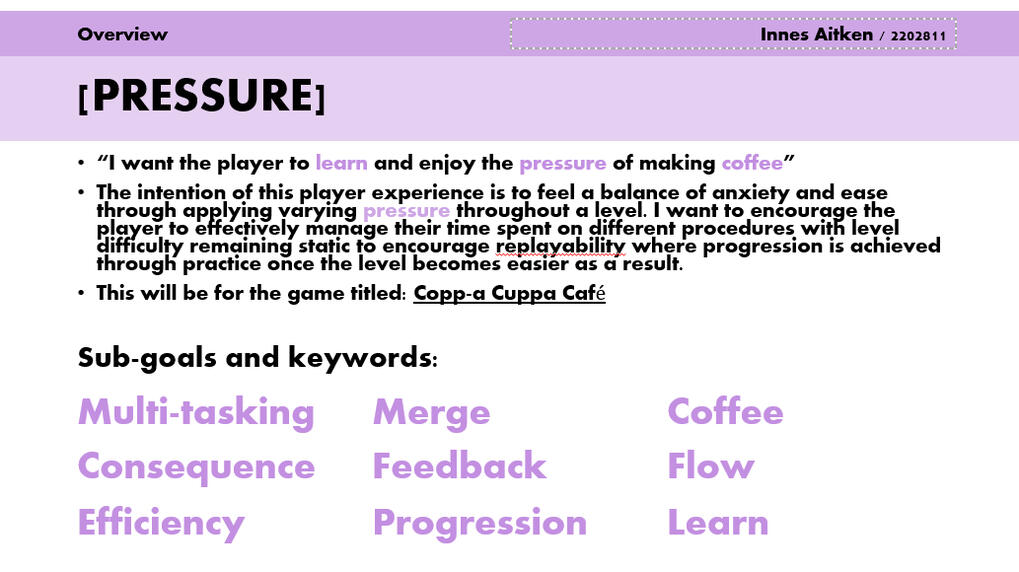


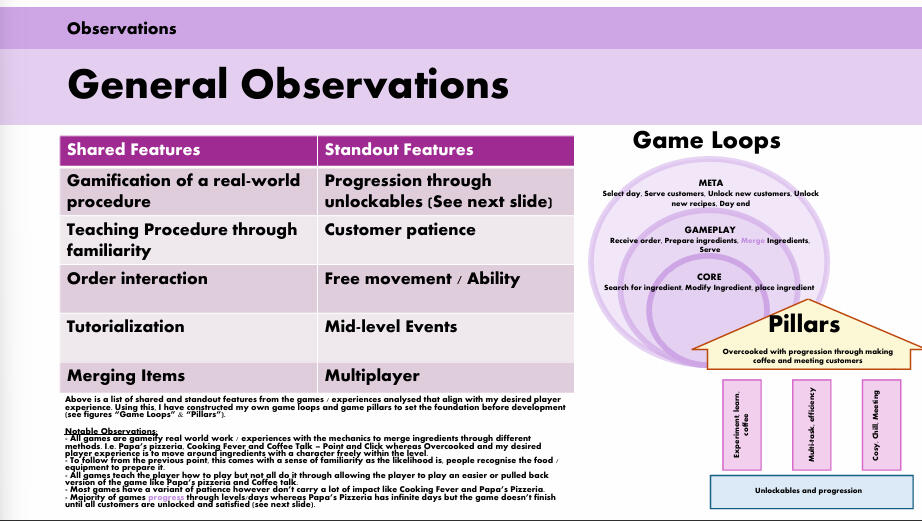
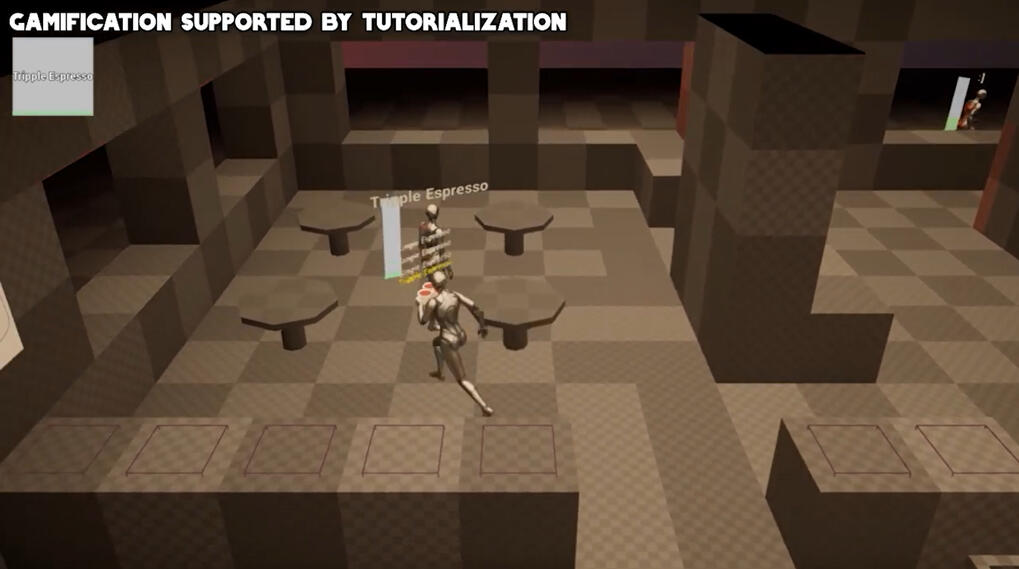
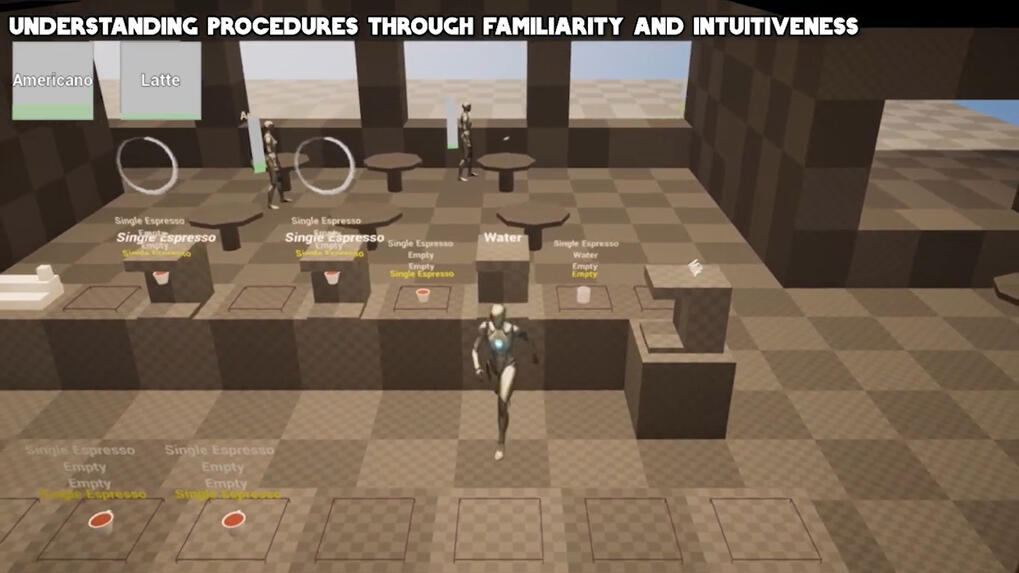
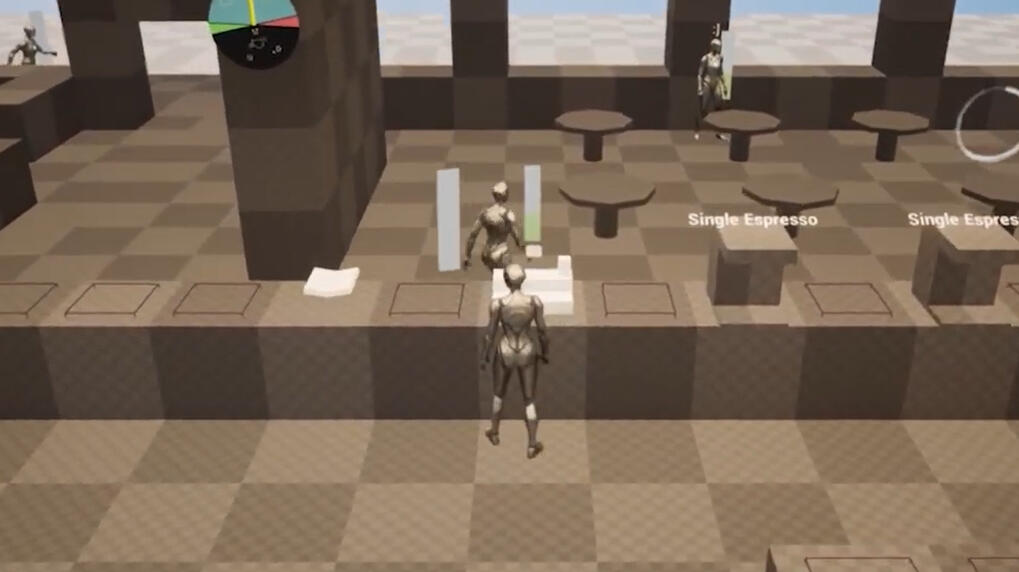
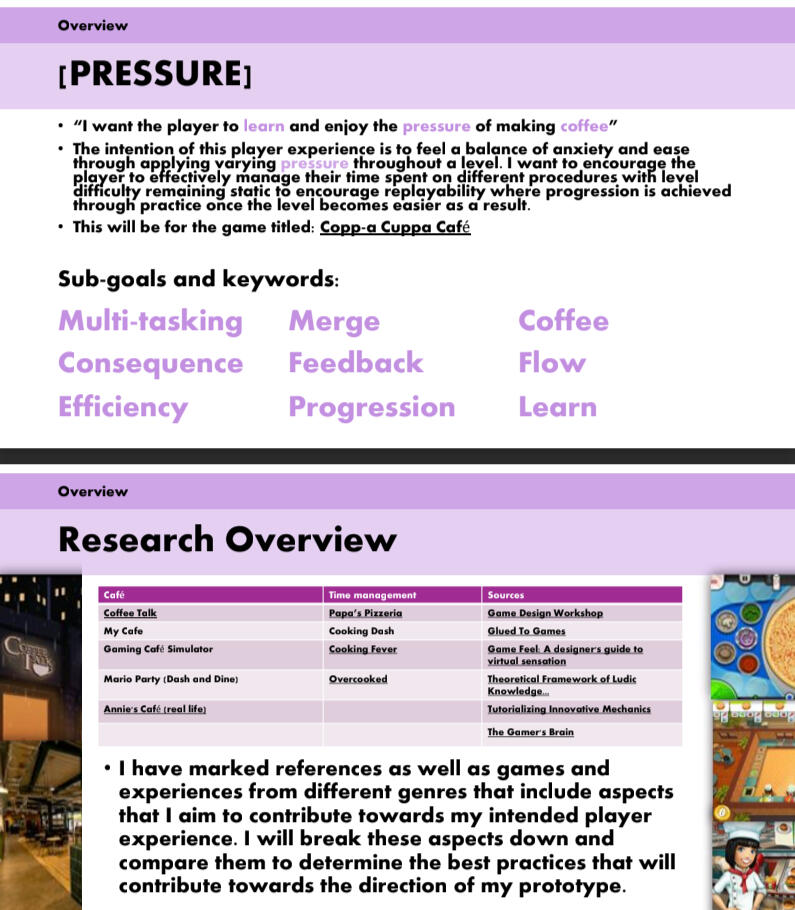
Project Summary
Research Overview:
For my project, I wanted to induce fun through the application of pressure. For this, I had looked at a variety of different games within the Coffee / Cafe and Time management genres as well as a variety of different sources to find examples that I could apply to my own prototype.Coffee Deconstruction:
For this section, I had looked at my experiences as a barista and a game called Coffee Talk and compared these experiences to understand the gamification of coffee making and achieving intrinsic motivation within the player to have fun partaking in ideas that come from a retail job.Time Management Deconstruction:
The next section I covered was about time management within games such as Overcooked, Papa’s Pizzeria and Cooking Fever to understand the concepts of Learning Procedure, Progression and Intensity as ways of applying and maintaining pressure in a game.
Observations:
From my research, I highlighted shared and standout features to understand how these games can apply pressure in a way that feels unique to the player and fun to engage with.I then took this and labelled the best practices for myself to take into making my own prototype: Copp-a Cuppa Cafe
Copp-a Cuppa Cafe:
This is a coffee-making game where you play as a Barista in an understaffed cafe and you have to do everything yourself.For this I wanted the player to feel a balance of anxiety and ease through applying different levels of pressure throughout a level. From this, the goal for the player is to effectively manage their time and learn through replaying the levels and perfecting their strategy in order to progress.The game’s losing condition is to disappoint 3 customers by not making their drink correctly or taking too long to create it. The win condition is to make all the drinks that you can whilst staying under the 3 mistake threshold.Customers appear and wait at the till where the player will need to interact with them to take their order and they will go to find a place to sit.The game works off a merging mechanic where different machines create different ingredients such as espresso, water, milk etc… you must combine these to form different drinks. For example, an espresso + milk + milk = Late.A focus for me was to take advantage of familiarity a player can have across games or transludic knowledge by making sure ingredients would be communicated effectively and coffee recipes can be guessable. There is also a recipe book with icons but that takes time to read!
Submission:
Research Document:
My submission is a research document deconstructing existing games to influence my practice in applying pressure within my prototype.Grade Received: B
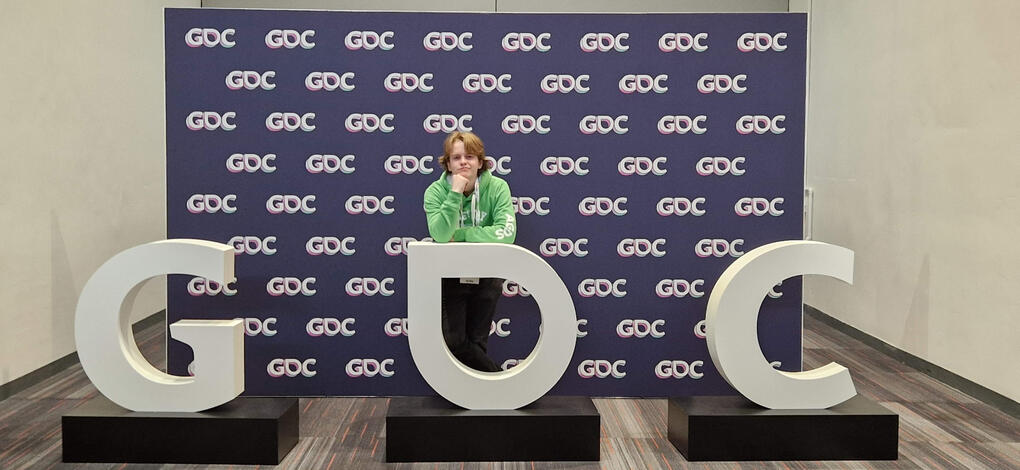



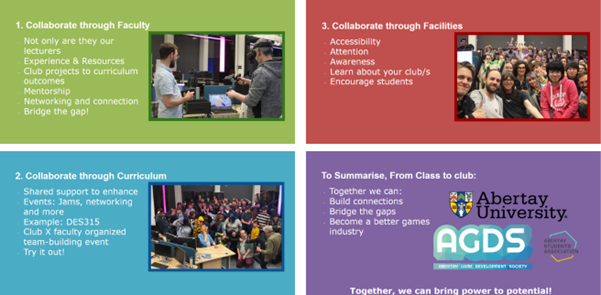
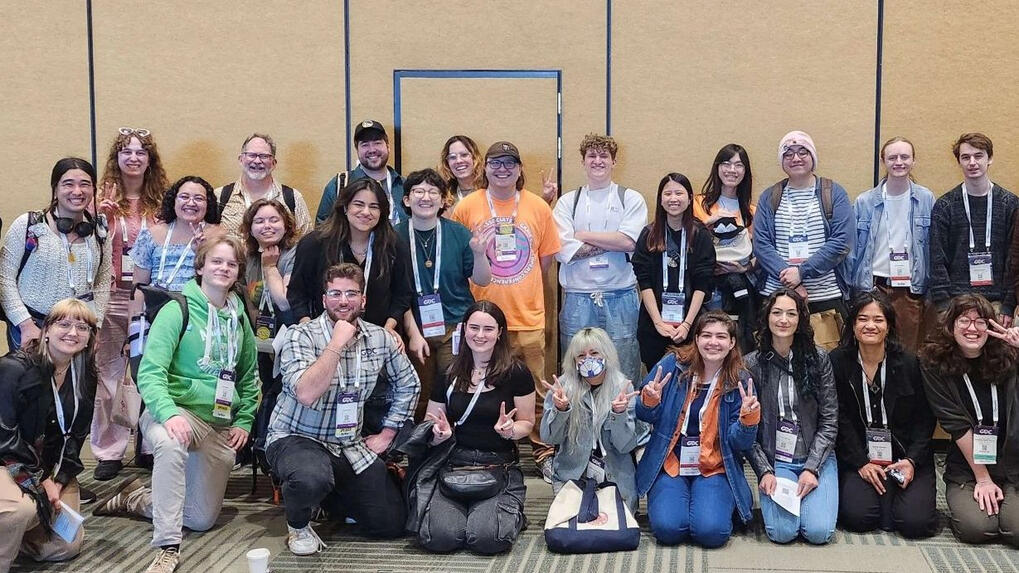


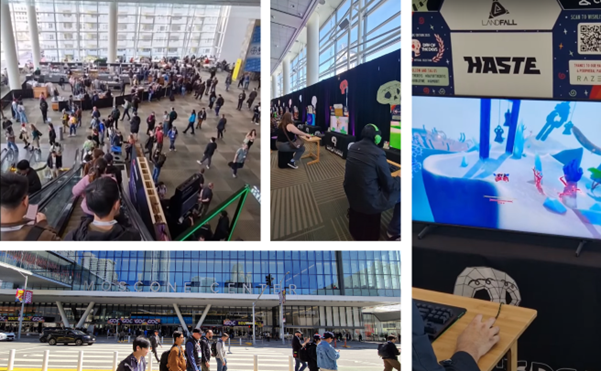



Summary
I went to the Game Developers Conference 2025 to speak at the first ever student led talk about Game Clubs like AGDS and why they are important for the future of game industry.
Game Developers ConferenceRunning for over 25 years, GDC is the world’s largest professional game industry event and week-long gathering for developers, industry leaders, educators and companies for a mix of talks, workshops and showcases in the latest innovations in games.Representation
As I was representing Abertay and the Abertay Game Development Society, I had been asked to take some videos and photos of my travels. Upon my return I had edited these into short videos for m University to upload to their social media platforms to show off this opportunity.
Our Talk:
Your School’s Secret Weapon: Fostering Game Development Clubs:This micro talk panel provides a holistic perspective on game clubs from stories from students in Denmark, Quebec, Singapore, and 5 US states, student club leaders in California and Scotland, along with faculty, alumni, and industry perspectives. Together, these voices create a story of how game clubs are valuable to universities and students, then how any interested faculty member can help their campus’s student game development club.
Jonah, Myself and Anastasia represented club leaders from the focusses of analysis, curriculum and community. Then we had Tad and Allyssa who represented the Lecturer and Industry perspectives. It was a great line up of people that could cover all basis!My section focused on the academic side of things ,which was split into 3 sections of Faculty, Curriculum and Facilities. Doing this, my goal was to highlight: The common goal of faculty and students have in trying to bridge the gap between Universities and Industry by utilising connections and alumni, which at AGDS, goes as far back as 14 years ago!
Also how we here at Abertay have worked with lecturers to collaborate through coursework and vice versa with the DES315 Professional Project module led by Mr Martin Lynagh.
Finally, by empowering students by helping them realise their potential by getting involved. I was lucky to have done a module all about game jams called DES101 by Dr Mona Bozdog where she had pointed me in the direction of AGDS when I was looking to do more.
To summarise my talk, I believe that the key to building the a better games industry is to invest into our future by bringing students closer to industry, ultimately, bringing power to potential.
My Journey:
There were so many games to play and fantastic people to talk to, I had to find some spots around San Francisco to just kind of chill out and meet people between talks. I was very lucky to have an all-access pass by being a speaker which costs a lot! With this, my strategy to GDC was to mark down every talk from ‘must-go-to’ to ‘back-up’. I wasn’t intending to go to every talk that I could as conferences can be very full on and you only have so much energy so instead have a schedule to look at when I felt like going to one. My thought process was that, everyone from across the world from students to leadership in games were all in the same place so there was no chance I was sitting down watching talks for my whole time there as I had people to meet!Notable people I met:
My co-panellists of course! – They were all more familiar with San Francisco and the states and had their peers from their own clubs and industry buddies that had me feeling as welcomed as possible. It was great to meet them all.Familiar Faces from Dundee – Abertay Lecturer Darshana as well as Founder & CEO of Team Terrible, Greg. Good to say hello and chat and hear about their plans for their busy weeks ahead.Unexpected Surprise – Student Association CEO, Elley had connected me with the second president of AGDS, Kirsty who ran the society just over a decade ago! Great to hear how things were different and have evolved over time.Friendly folks in Industry – GDC had a very neat networking app where you could request to chat with all attendees of the event. For this I had attended a talk about the value of empathy and how it can foster great meetings by Michelle Olson. I loved the talk and met up with her later in the week to hear more of her story and get some advice that I could take back home with me to Dundee.
Watch our talk:
If you are interested to know more, our panel is now logged on the GDC vault alongside the biggest names in games which all Abertay Students have access to and use for their coursework. Watching our talk requires Vault membership as of writing this.Thank you to Jonah Ryan for inviting me onto the panel alongside Anastasia Naydina, Tad Leckman and Alyssa de la Tore
Built To Quill
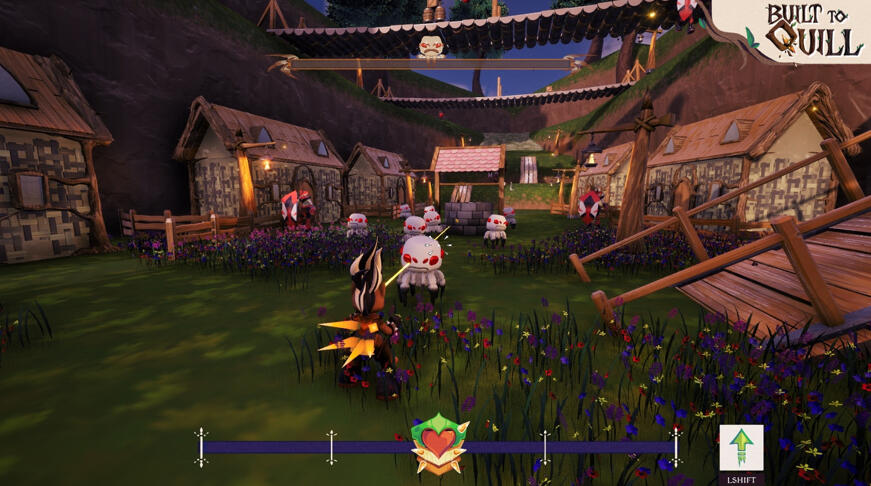
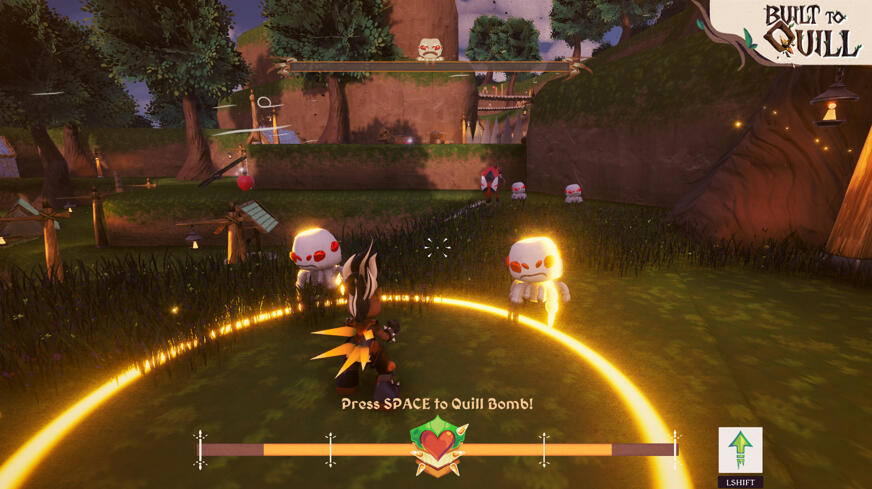

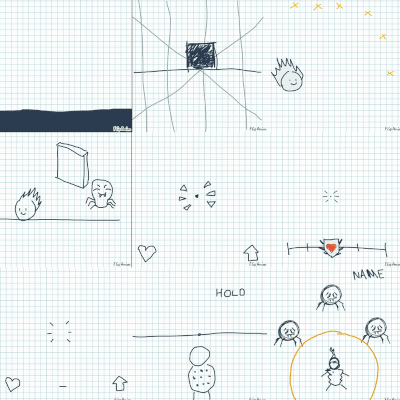
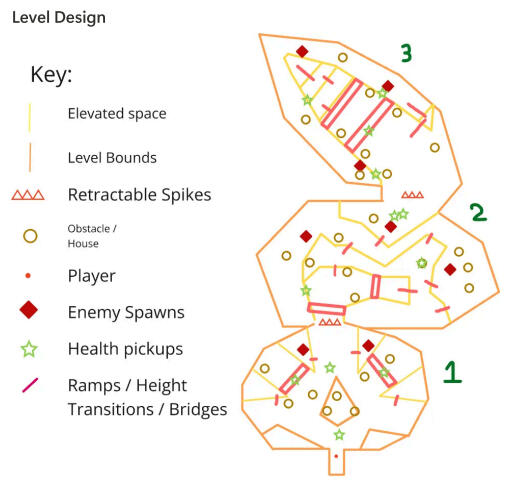


Project Summary
“Built to Quill” is a collaborative game development project by team Cosmic Cat. It is a third-person, strategic movement shooter for PC where you play as a porcupine reclaiming their village by battling waves of enemy bugs. This game’s development involved the phases of production using the AGILE game development process.I did this project for my DES315 professional project module, with all of the different games courses and disciplines at Abertay. For this project, my main role was the team’s designer, and my secondary role was programmer. We were working for an industry client 4J studios.“Built to Quill is a third-person, strategic movement shooter for PC in which you play as a porcupine who has lost her entire village to the wrath of the bugs. In the slaughter, you made it out. But not intact. With your quills all gone, you have spent your time away preparing for revenge, crafting an armour that covers your fragile body, one that allows you to attack en masse.““Repel quills at enemies with the ability to attract them back, dealing damage both ways. This armour adds even more quills than was previously thought possible by all porcupine kind, but don’t get too excited… your ammo is your armour. Although your enemies hit hard, with your armour you can quill out, and reclaim your village now that you are Built to Quill.”
Design:
Rotisserie Technique:
Coming into the project, I had my own method for ideation that encouraged building an idea that can be shared with the whole team through iterative, smaller ideas and notes from other team members. This would begin by noting concepts onto a board and going around them to see what can be developed further, merged, remain unchanged or be removed from the board, resulting in creating a fun and efficient process to ideate collaboratively.Game Design Document:
For this project I had created a design document that would be revised weekly and matched up with gameplay for any inconsistencies in the form of design notes released every sprint to align future tasks with the GDD. I would compare this document to Industry used documents to ensure my ideas were being communicated well and professionally. Something I had found useful was to make simple animations as a “prototype, to a prototype” to ensure the teams and my own ideas were understood across the team before taking the time to develop them further.Design Meetings:
To complement my sprint design notes, I would organise regular design meetings with varying members of each discipline and the producer to establish a consistent understanding of our game that affects these disciplines. This would also be used as a decision-making time for our pivotal decisions in the project, such as adjusting the game according to client/mentor feedback or major design changes with our client, mentor and team’s best interests in mind.Level Design:
One of my highlights of this project was taking the opportunity to develop my skills in level design. Figure out a process to iterate between sketches blockout and refinements to achieve a level that would satisfy the lessons we wanted to teach the player at each part of the game. This had involved creating a level flow/timelines to find any gaps in information and context the player should interface with.
Feedback & Submissions:
Our prototype was praised to be an “imaginative, engaging and functional piece of interactive media. Responding to the initial prompt and further requests and feedback, the team delivered an excellent prototype.”I had received feedback from my academic mentor for:
– respect, professionalism and engagement within the project with a proactive approach to plan and set tasks.
– Ability to communicate problems promptly as well as take feedback well and refine and engage with others to find a solution with the best interest of the project in mind.
Throughout all of my project and personal submissions and observation from my tutor, I had evidenced excellent commitment and effort throughout the project making “many key contributions to the project”.
From this experience, I had learnt important lessons surrounding communication with different disciplines and the art of converting ‘English to English’ as well as developing skills in providing constructive feedback.Week-by-Week Documentation:
Our journal includes work from all disciplines towards the final product. It also includes feedback we have received from our clients at 4J Studios and our approach.Group Grade: B+
Personal Grade: A
Abertay Game Development Society
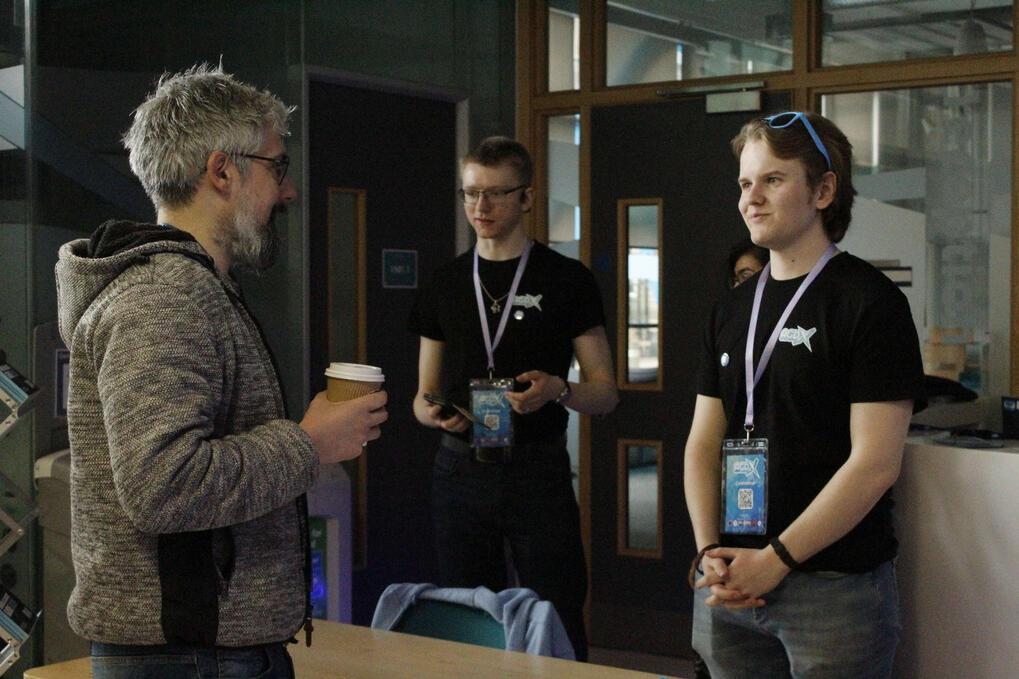

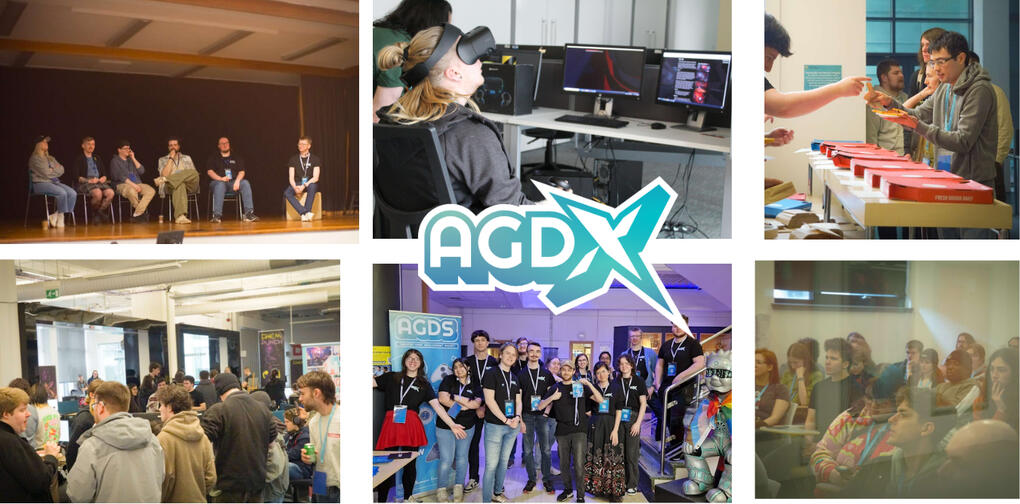

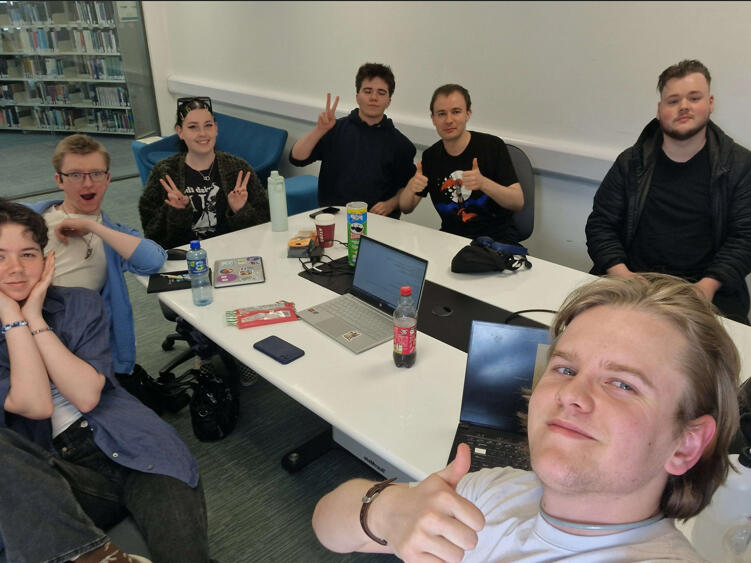
AGDS is...
The Abertay Game Development Society or AGDS is a community of people interested in all disciplines and practices within game development. We work with a mixture of our members, Abertay staff, Industry and sponsors to deliver fun and engaging events for those looking to have games as part of their career or intrigued by the process. Running events like Industry talks, Game Jams and experimental events throughout the year.I started my journey as a game jam coordinator, encouraging students to start making games together instead of waiting for their third-year projects.
Game jam coordinator 23-24:
– Organising and leading a mixture of events/experiences for the public and members of the Abertay Games Development Society.
– Meetings with Industry professionals and public speaking alongside them.I had enjoyed my experience working for the society and decided to run and be successfully elected as their President for the following year.
President 24-25:
– Organising and leading a mixture of events/experiences for the public and members of the Abertay Games Development Society.
– Meetings with Industry professionals and public speaking alongside them.I had enjoyed my experience working for the society and decided to run and be successfully elected as their President for the following year.
Our year summary
📢 16 different talks from a variety of experienced professionals in all disciplines.
🕹️ 76 Submissions over 4 different game jams.
💙 Founded the Abertay Game Development Expo, which is a day involving a showcase and a series of speakers culminating in an industry panel.
👋 Began volunteering opportunities to involve our community with our Brand, Events and AGDX.
🧊 A team represented AGDS and Abertay at the V&A in a competitive game jam.
🧑🏫 AGDS was represented at Game Developers Conference to spread awareness of game clubs just like it and the benefits of starting them.
🍕 And of course, we hit an AGDS record of 592 slices of pizza eaten.
Additional
Management and process systems design using notion.
Designed an “Idea-to-Event” pipeline to collaboratively create and execute events by as forum ideation, proposal systems and responsibility assignment.Handover and Training
Documents and training sessions created and used throughout the year for onboarding new committee members, training new societies and handing over to the next committee. This was accompanied by my creation of the first iteration of the Committee handbook.Check it out!
The Abertay Game Development Society has been a gift, and I have learned so much within these teams of passionate people. Grateful towards Abertay University and the Abertay Students’ Association for their help towards us achieving the above! I highly recommend that students and game developers local to Abertay, Dundee, check it out.
Sun Dog
Project Summary
"Sun Dog" is a game submission made as part of a 8 person inter-disciplinary team for the Hub world Summer Game Jam Jamboree 25 with the theme of Factor 50.For this project I had a goal of working on my skills in production and leadership with a strong curiosity into the process of team formation and talent acquisition. For this my primary role was production with design as a secondary role."Play as a dog desperate to quench their thirst over some cold beer... but dogs don't buy beer. Trade sunscreen with sunburnt people to get their clothing, disguise yourself and buy a beer... but dogs don't have money...Explore - The island and meet the locals!
Fetch - Lost items for money
Sunscreen - Others in exchange for a disguise
Finally - Get your Beer!"
Production:
Organisation:
From the organisation of the team. I had conducted research of students from other teams that I had not met before as well as reached out to people I knew and have worked with in the past. From this rapid team formation process, I had worked with the early team members to fill the remaining gaps within the team and posted in community spaces to fill the remaining spaces. From this we had our first meeting where we started off with an ice-breaker playing games online to then list all of our skills to influence our brainstorming using the rotisserie technique.Rotisserie Technique:
Similar to previous projects we had used the same technique for collaborative ideation which resulted in an idea that can be shared with the whole team through iterative, smaller ideas and notes from other team members. This would begin by noting concepts onto a board and going around them to see what can be developed further, merged, remain unchanged or be removed from the board, resulting in creating a fun and efficient process to ideate collaboratively. The team had a positive influence to the technique itself as being a full remote team was originally thought to be a constraint but having everyone on the same workspace simultaneously actually led to an ability to delegate ideation whilst discussion was happening. These waves of background iteration whilst chairing to ensure everyone was maintaining group effort led to some funny and ultimately productive contributions to form a shared idea.Task Management
For this jam, I had wanted to challenge myself by using a primitive method being a simplistic excel sheet made for the jam. This was an interesting challenge, requiring me to utilise a good understanding of the processes involved with task assignation, delegation and completion. It was a blank canvas in comparison to using sites like Trello, Jira and Click up.
Design:
Level Design:
The only design work required of me for this jam was iterating on the level for the programmers and artists to work with when setting up and blocking out the level.Artifacts we had to take into consideration for our game were things like object placement especially for a game without a tutorial, the natural flow we were to create had to onboard the player. This was a cheap alternative than creating a separate level or in depth mechanics to teach the player how to play.Some notable objects we had set up were NPC positions and their desired items. Coin positions and balancing in order to complete the game whilst enticing the player to complete all option quests.
Closing:
Overall, the team had done a great job putting together an ambitious game in a short amount of time. It was fun to see the game enjoyed at the jams play party.
DES205 Level Design
Project Summary
DES205 is a module that focusses on the principles of level design where students are tasked with creating a level according to a theme. For my theme I had chosen adaptation of an existing media's ideas. This was the representation of emotions in the movie "Inside Out"."I want my level to be set in the brain of a person and the goal is to find and restore the emotion cores to provide stability to the person. I plan on creating a first person, puzzle game similar to Portal(2007) where there will be mechanics the player must play and experiment within order to progress. My concept fulfils the brief as I plan to adapt concepts from the movie like the emotions Joy, Fear, Anger and Sadness into characters with mechanics the player can interact and experiment with."
Design:
Research:
I had conducted research on existing games that I wanted to take inspiration from for the goals I set to achieve in the module. To provide an example of one of my goals was to create a level that had "fundamental basis to get from point A to point B by completing puzzles". For this I had looked into games like Portal and how it would allow the player to experiment with modular sections to break away from the linearity which made up the majority of the game.A notable goal of mine was to have subtle references to emotions that could be used as mechanics. An example of this being that key emotions like happiness, sadness, anger and fear were represented as robots with varied ability based on a play on words. For example, Happiness was a ball of energy that would power sockets to help the player proceed to the next section.
Feedback & Submissions:
Grade Received: A







